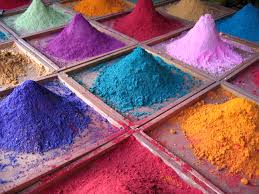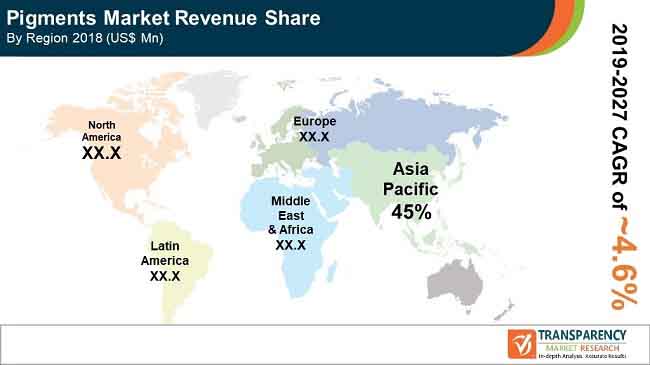
Pigments Market: Overview
- Pigments is a group of compounds that are intensely colored and are employed to impart color to other materials. They absorb the light of selective wavelength and then emit various colors through the process of reflection or transmission. Pigments are used to improve the appearance of a substrate on which they are used or impart color to the medium in which they are used.
- Pigments can be organic or inorganic. Organic pigments are based on carbon chains and carbon rings. However, they can also contain metallic elements that help stabilize properties of the organic component. Inorganic pigments are usually metallic salts precipitated from solutions.
- The particle size of inorganic pigments is larger than that of organic pigments. Pigments can impart a versatile range of colors to paints, coatings, plastics, inks, etc. while improving their aesthetic properties. These help enhance properties such as opacity, hiding power, light and weather fastness, heat stability, and tinting strength.

Request Brochure:
https://www.transparencymarketresearch.com/sample/sample.php?flag=B&rep_id=905
What are Key Growth Drivers of Global Pigments Market?
- Paints & coatings is the dominant end-user segment of the pigments market. Pigments are used extensively in the formulation of paints. Pigments impart color and a glossy effect as well as improve aesthetic appeal of paints and coatings. Usage of pigments helps impart brightness, heat stability, and light stability to the paint. The architectural paints & coatings industry has grown considerably owing to rise in infrastructure development and construction activities in developing economies. Furthermore, growth of automotive and consumer goods sectors has boosted the decorative paints & coatings industry. The paints & coatings industry in developed countries witnesses higher per capita consumption, but sluggish growth. The per capita consumption of paints in developing countries is lower than that in developed countries in Western Europe. The per capita consumption of paints in India, China, Singapore, South Korea, and countries in ASEAN and GCC is likely to increase significantly in the near future, due to the economic growth. Thus, growth of the paints & coatings industry is likely to be a key driver of the pigments market during the forecast period.
- Increasing plastic consumption is another driver of the market for pigments. Pigments are employed as colorants in a wide range of plastics owing to their excellent compatibility with several plastics. Pigments impart unique appearance and styling effects to plastic products. High-performance organic and inorganic pigments are used in the plastics industry. Pigments are employed in PVC pipes, window profiles, vinyl siding, and gutters. Pigments applied in the plastics industry guarantee maximum color strength and stability and low coloring costs. Besides coloring effects and improved esthetics, pigments increase the stability of plastics and improve their resistance to weather conditions such as heat and moisture.
More Trending Reports by TMR:
What are Key Challenges for Global Pigments Market?
- Pigment manufacturers are focused on maintaining environmental sustainability owing to the rise in consumer awareness about the usage of eco-friendly products. Producers of pigments experience challenges in terms of adverse environmental effects of pigments.
- Azo compounds are extensively used in paints & coatings due to their excellent coloring properties. However, toxicological effects associated with the unregulated usage of the compounds lead to high environmental risks. Reduction of azo compounds can release a number of aromatic amines, which can be detrimental effects on human health. These amines can be produced by reductive cleavage or hydrolysis of anilido bonds present in azo compounds. These aromatic amines induce genotoxicity and carcinogenicity in humans. As a result, the European Commission (EC) has imposed stringent restrictions on the usage of these dyes.
- The Ecological and Toxicological Association of Dyes and Organic Pigments Manufacturers (ETAD) has not specifically restricted the usage of azo pigments; however, some azo pigments can cause significant health hazards. Photocleavage initiated by solar radiation can degrade some azo pigments despite their low solubility. This, in turn, can result in the release of harmful aromatic amines of more than 30 ppm, which is beyond the detection limit set by ETAD.
Buy Now:
https://www.transparencymarketresearch.com/checkout.php?rep_id=905<ype=S
Lucrative Opportunities for Players in Global Pigments Market
- Technological breakthrough in the development of nanomaterials has opened new avenues for the advancement in several industries. Nanotechnology has emerging usage in the pigments industry. This is expected to create lucrative opportunities in the market in the next few years.
- Nanopigments are rapidly gaining popularity in various industrial applications owing to their superior performance than the conventional pigments. Nanoparticle of organic and inorganic pigments having particle size less than 100 nm can be developed.
- Usage of nanotechnology in the production of pigments improves their tribological, mechanical, and optical properties. Nanopigments offer key advantages, such as durability stability to UV radiation and heat; enhanced hardness and toughness; resistance to scratch, abrasion, and weather; improved transparency; and decreased water permeability, over traditional pigments.
- Nanopigments can also be used in novel applications such as cosmetics, photovoltaic cells, cathode ray tubes, and ceramic pigments. These pigments have smaller particle size, which leads to a larger surface area. Therefore, advanced technology is required for the application of nanopigments for surface treatment and dispersion.





